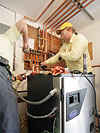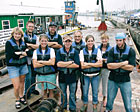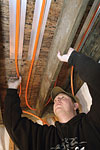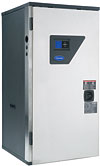
Techs solder the supply line to a geothermal heat pump, which is now providing energy-efficient and needed comfort for volunteer cleaners of the nation’s major rivers and watersheds.
EAST MOLINE, Ill. - CBS News refers to Chad Pregracke as “The river’s garbage man.” When volunteers, corporate sponsors, and network media follow in his footsteps, they track him through miles of river mud and coastal waterways. This is his element, and the trail is strewn with debris.
Pregracke’s been cleaning the great Mississippi for most of his life, a mission now aided by a team of devoted employees and volunteers for an effort that now has a name: Living Lands & Waters (LL&W).
The not-for-profit environmental organization has a mission to aid in the protection, preservation, and restoration of the natural environment of the nation’s major rivers and watersheds. (See related online feature article “A River Runs Through Him” in this issue.)
PUMPING OUT THE HEAT
The rigors of working on the river can take its toll on employees and volunteers alike, especially when it’s cold and wet outside. So it’s no surprise that, when Pregracke was compiling his dream-sheet for their new building last year, with office, storage and workshop spaces, energy efficiency and comfort were on the list. Too often, the two are mutually exclusive.“But not when you can combine radiant heat, which we thought would be wonderful to have for the office spaces, and necessary for the shop . . . with the greenest of energy sources for the heat: geothermal,” said Pregracke.
Gabrilson Indoor Climate Solutions, based in Davenport, Iowa, provided the skills and equipment to fulfill Pregracke’s dream. According to Gary Stuckel, vice president of the firm, Dave Pollitz, senior service technician, and Denny Heffe, residential installer, spent several days connecting an extensive radiant heat system to the first-ever commercial installation of Carrier’s water-to-water geothermal heat pump - the manufacturer’s new, high-temperature, 3-ton geothermal unit, which the company said is designed specifically for duty with radiant heat and snowmelt systems.

The Living Lands & Waters team, from left: Madeline Luloff, Tony Borreson, Kristen Ellis, Chris Fenderson, Chad Pregracke, captain Mike Hanlin, Tammy Becker, Anne Powers, and Mike Coyne Logan.
“The heat pump’s outgoing temperature is remarkable,” said Pollitz. “Typically, ground-source heat pumps produce temperatures of 115° to 120°. We’re delighted that we had the chance to install the first of these Carrier systems. When we made the final connections for Chad’s facility, the temperature and system performance were right on track and, once the slab was brought up to temperature, the building was perfectly warm inside.”
Because this unit was a new design, it was important to receive real-time data from the system, according to Kent Kuffner, product manager for the company’s geothermal and IAQ equipment.
“Carrier’s geothermal engineering team monitored its performance continuously with the help of a PC [personal computer] that was set up there,” said Kuffner.

Installation of Watts Radiant ePEX tubing under the mezzanine area included extruded aluminum plates for optimal heat transfer.
MONITORING IT ALL
For six months, system performance was monitored. The heat pump’s control panel was set aside. In its place, sensors fed data to the PC, which steadily communicated real-time information about system performance and efficiency.The building rests atop a 40-foot by 60-foot insulated concrete slab. Twenty-eight hundred lineal feet of RadiantPEX tubing from Watts Radiant was installed prior to the slab’s concrete pour. Another 1,200 lineal feet of the manufacturer’s Onix EPDM tubing was stapled up to heat portions of the building’s second floor.
“When we made the connections between the heat pump and its three, 300-foot-long geoexchange loops, each submerged in its own bore hole, and the radiant heat system, most of the zoning, pumping strategy, and system control were already done,” said Pollitz.
A small, self-contained HydroControl panel by Watts Radiant reduced site work to plug-n-play, he said. “Hot water came in on one side from the heat pump, went into the panel and, from there, the building’s three radiant zones and two temperatures were handled entirely by the panel,” said Pollitz.

…And now to enjoy a job well done: Chad Pregracke (center) takes a moment with Gabrilson’s Dave Pollitz (left) and Denny Heffe (right).
DOG GONE MYSTERY
One day last winter, the monitoring personnel were surprised to notice a substantial change in the energy required to maintain building temperature. They were mystified. So they called LL&W to ask about it. How could the energy use have jumped so dramatically?Initially, the LL&W staff couldn’t find an answer. But eventually they narrowed it down to the partially opened garage door.
One of the office staff had opened the door about two feet to allow the office mascot - Jib, a 130-pound, dutifully house-trained yellow lab - to come and go.
“The spike in energy use was an odd but effective way to learn, in real time, that something had changed substantially at the test site,” said Kuffner. “It was a testament to the effectiveness and accuracy of the onsite test equipment, feeding detailed information to us remotely.”
Madeline Luloff, office manager at LL&W, is pleased with the system’s energy efficiency.
“Last fall and winter, the average monthly cost for heating was about $100 per month, with a peak of around $200 in February, when the average outdoor temperature was 22°F,” she said.
Luloff is just as happy with the comfort the system provides, too.
“The heating system is wonderful,” she said. “The heat from the floor is so pleasant and consistent. We’re all very comfortable inside, especially when winter is at its worst. This is my first experience with geothermal and radiant heat. I’d love to have a system like it in my home.”

Pictured is Carrier’s new, high-temp, water-to-water (50YEW Series) geothermal heat pump.
Sidebar: Regarding Installation
When it came time to supply heat to their building, Chad Pregracke and the folks of Living Legends and Waters (LL&W) opted for a geothermal heat pump - specifically, Carrier’s new, high-temp, water-to-water (50YEW Series) unit that operates with Puron® (HFC-410A) refrigerant.The manufacturer said new compressor technology has provided the ability for its new product to generate leaving water temperatures of up to 145°F, even at ground-loop minimum temperatures. Double-isolated compressor mounting, discharge and suction mufflers, and fully insulated compressor section make it “one of the quietest units on the market,” said the manufacturer.
Standard features include high temperature output, integrated controls, outdoor temperature reset, and warm weather shutdown. Carrier said it is “an excellent candidate” for natural gas, propane, or fuel oil boiler replacements.
The 50YEW Series are available in sizes 8, 10, and 12kW in 50Hz voltages and size 10kW for 60Hz voltages, capacities at ground loop heat pump conditions, said the manufacturer. Also, the heat pump can attain ground loop efficiencies (COP) “25 percent higher than current units on the market,” it said.
Publication date:09/08/2008

Report Abusive Comment